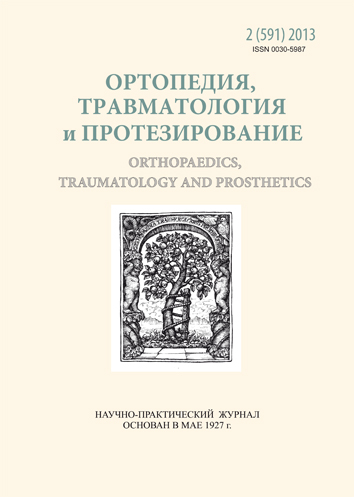Regeneration of the bone tissue in osteosynthesis with implants made of magnesium-based alloys in experiment
DOI:
https://doi.org/10.15674/0030-59872013245-50Keywords:
fracture, osteogenesis, magnesium, implantsAbstract
Peculiarities in the regeneration of a fracture of the femoral bone after osteosynthesis with rods, made of ÌË-10 magnesium alloy, were studied in 12 pubescent rabbits. In control animals, a modelled fracture of the femur was followed by osteosynthesis with intramedullary fixing devices, made of stainless steel. When the animals were taken out of the experiment, the femur was sawn through the fracture area together with the graft. It was found out that the healing of femoral fractures in animals in conditions of using grafts, made of a modified magnesium alloy, did not differ from the processes of reparation, observed in controls. The consolidation of the fracture took place within the same terms and without any pathological disturbances.References
- Alabut A. V. Experimental and clinical rationale for the use of nickel-titanium structures in traumatology and orthopedics: diss. ... for obtaining academic degree candidate. honey. science / A. V. Alabut. — Rostov-on-Don, 2003. — 240 p.
- Staroha A. V. The functional outcome of patients with an abscess of the nasal septum using elastic permeable implants / A. V. Staroha, A. V. Davydov, A. S. Prosekin // Bulletin of the Siberian medicine. — 2005. — App. 1. — P. 46.
- Kraynov E. A. Morpho-functional characterization of bone formation using implants with bioceramic coatings: diss ... for obtaining academic degree candidate. honey. science / E. A. Kraynov. — Volgograd, 2009. — 283 p.
- Kopysova V. A. Experimental study of osteosynthesis fixation of porous NiTi / V. A. Kopysova, V. A. Gorodilov, V. V. Kishkarev // Actual problems of implants and osteosynthesis. — 2000. — P. 27–29.
- Bioresorbable polymers in orthopedics and traumatology / V. A. Radchenko, N. V. Deduh, S. V. Malyshkina, L. M. Bengus // Orthopaedics, traumatology and prosthetics. — 2006. —№ 3. — P. 116–124.
- Krasnoyarov G. A. Surgical treatment of diseases of the musculoskeletal system in children and adolescents through the use of biocompatible and physiologically active composite: materials ... thesis for obtaining the academic degree of doctor. honey. science / G. A. Krasnoyarov. — Moscow. — 2004. — 185 p.
- Pogorelov N. V. Injured bone mineral metabolism in normal and violations of water-salt balance / N. V. Pohoryelov // Morphology. — 2009. — T. III, № 3. — P. 90–94.
- Biorezorbtivnye properties of magnesium alloys / A. Y. Chemiris, E. I. Tsivirko, V. N. Chorny et. al. // Injury. — 2011. — № 3. — P. 144–147.
- Bioabsorbable fixation devices in trauma and bone surgery: cur¬rent clinical standing. / E. Waris, Y. T. Konttinen, N. Ashammakhi et al. // Expert Review of Medical Devices. — 2004. — Vol. 1, № 2. — P. 229–240.
- Daniels A. U. Mechanical properties of biodegradable polymers and composites proposed for internal fixation of bone / A. U. Dan¬iels, M. K. Chang, P. A. Kirk // J. Appl. Biomat. — 2004. — Vol. 1, № 1. — P. 57–78.
- Magnesium alloys as implant materials-principles of property design for Mg-RE alloys / N. Hort, Y. Huang, D. Fechner et al. // Acta Biomater. — 2010. — Vol. 6 (5). — P. 1714–1725.
- In vivo evaluation of biodegradable magnesium alloy bone implant in the first 6 months implantation / E. Zhang, L. Xu, G. Yu et al. // J. Biomed. Material Res. — 2009. — Vol. 90 (3). — P. 882–893.
- Magnesium and its alloys as orthopedic biomaterials: a review / M. P. Staiger, A. M. Pietak, J. Huadmai, G. Dias // Biomaterials. — 2006. — Vol. 27 (9). — P. 1728–1734.
Downloads
How to Cite
Issue
Section
License
Copyright (c) 2014 Maksim Golovakha, Vadim Chorny, Yevgeniy Yatsun, Sergey Tertishny, Konstantin Dikiy

This work is licensed under a Creative Commons Attribution 4.0 International License.
The authors retain the right of authorship of their manuscript and pass the journal the right of the first publication of this article, which automatically become available from the date of publication under the terms of Creative Commons Attribution License, which allows others to freely distribute the published manuscript with mandatory linking to authors of the original research and the first publication of this one in this journal.
Authors have the right to enter into a separate supplemental agreement on the additional non-exclusive distribution of manuscript in the form in which it was published by the journal (i.e. to put work in electronic storage of an institution or publish as a part of the book) while maintaining the reference to the first publication of the manuscript in this journal.
The editorial policy of the journal allows authors and encourages manuscript accommodation online (i.e. in storage of an institution or on the personal websites) as before submission of the manuscript to the editorial office, and during its editorial processing because it contributes to productive scientific discussion and positively affects the efficiency and dynamics of the published manuscript citation (see The Effect of Open Access).














